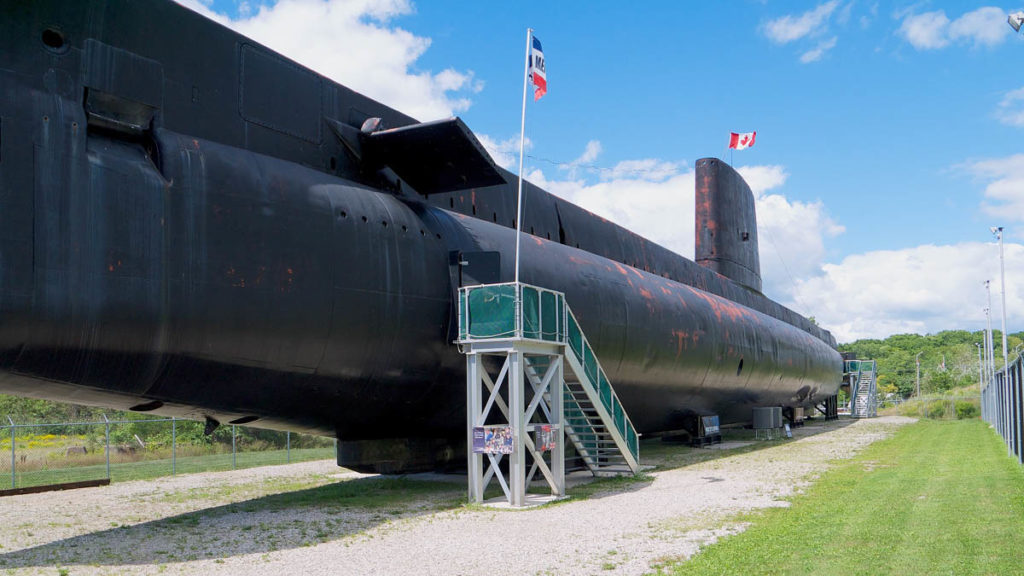The HMCS Ojibwa is Ontario’s only submarine that is open to the public for tours. The Oberon-class submarine HMCS Ojibwa served in the Royal Canadian Navy and later the Canadian Forces Maritime Command during the Cold War. The tours are offered in Port Burwell, Ontario, by the Elgin Military Museum (located in nearby St. Thomas, Ontario). The submarine was originally commissioned for the Royal Navy as HMS Onyx, with the keel laid down on September 27, 1962, at Chatham Dockyard. In 1963, the submarine was transferred to the Royal Canadian Navy, and on February 29, 1964, it was launched as HMCS Ojibwa. On September 23, 1965, Ojibwa was commissioned at Chatham Dockyard. The submarine was given the pennant number S 72 and was named after the Ojibwe First Nations people.
The Oberon-class submarine HMCS Ojibwa served in the Royal Canadian Navy (RCN) and later the Canadian Forces Maritime Command (MARCOM). The submarine, originally intended for service with the British Royal Navy as HMS Onyx, was transferred to Canadian ownership before completion and entered RCN service in 1965. Until her decommissioning in 1998, the Ojibwa served primarily with Maritime Forces Atlantic. Ojibwa was laid up at CFB Halifax in 2010 awaiting disposal, with the Elgin Military Museum intending to keep her as a museum vessel. In 2012, the submarine was towed to Port Burwell, Ontario, and opened to the public in 2013. She is now the focal point of a new Museum of Naval History that will be built alongside her.
The Oberon class was considered an improved version of the preceding Porpoise-class submarines, with a different pressure hull frame and a higher grade of steel. Because of these structural differences, the Oberons could dive to a greater depth of approximately 1,000 feet (300 m).
The Oberons in Canadian service had become obsolete by the late 1970s and needed to be updated. The program was approved in February 1979 after extensive planning in 1978. Maritime Command developed a refit program that included new sonars, periscopes, communications, and fire-control systems in an effort to transition the subs from anti-submarine warfare training to frontline service. They also had their armament upgraded, with torpedo tubes capable of firing the Mark 48 torpedo installed. This would allow NATO to deploy the submarines in the North Atlantic to monitor Soviet submarines.
Between 1991 and 1994, following the end of the Cold War, the Oberons were retasked, performing patrols on behalf of federal institutions such as the Department of Fisheries and Oceans and the Solicitor General of Canada. The submarine served on the west coast for six months in 1994.

The Halifax Chronicle-Herald reported in May 2005 that MARCOM was looking to sell Ojibwa for scrap metal, along with three other Canadian Oberons. MARCOM stated that the submarines were not in good enough condition to be used as museum ships, and that each submarine would sell for between $50,000 and $60,000. She was a target in “shock” testing after decommissioning in 2010, resulting in a noticeable dent on the port side.
On June 11, 2010, it was announced that BMT Fleet Technology Ltd would relocate Ojibwa to the Elgin Military Museum in St. Thomas, Ontario. The transfer of Ojibwa to the Elgin Military Museum was approved by the Department of National Defense on December 2, 2011, subject to financial requirements being met. After three years of negotiations, the final agreement was signed on May 25, 2012.
After a short journey, the submarine arrived in Port Burwell on November 20 and became part of a new Museum of Naval History. On June 29, 2013, the site opened for tours. The financial issues surrounding the transfer of the submarine to Port Burwell were widely publicized in April 2015, as Royal Bank of Canada demanded that the community repay the $6 million loan.






